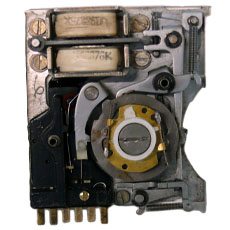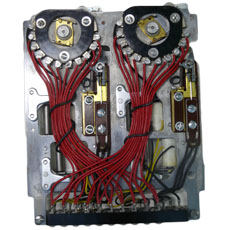In this case we are dealing with an 11-digit, decimal, electromechanical block computer unit (1920 - 1935). The add carry for all four basic arithmetic operations is mechanical stored and performed. The electromagnets are electric driven with a direct voltage of 110 volt.

In todays computers calculations are executed in the CPU, the heart of every computer. The separate components, which make these calculations possible, are millions of small transistors, in modern processors already billions. Each of those transistors has a size of a few nanometers what means that it isn't visible to the naked eye. But the commencement of this technique was another. Back then those arithmetic units were comparatively big mechanic components. This exhibit shows such a component. This is a monadic, decimal, electromechanical arithmetic unit, which was used in the mainframe ASCC, also known as Harvard Mark I. This computer was used for the first time in 1944. It worked fully in the decimal system (the number system, which we use for calculations in everyday life), which was represented amongst others by such arithmetic units. In calculations it was used for the unit position. The ten carry mechanism in this unit was saved mechanically and executed electromechanically. Using a gear drive it synchronized with other components of the computer and later was used in the calculating punch or the tabulating machine.

This exemplar could solve one arithmetic operation in less then a half second. Carry on paper was already hard for some students. In this case Arithmetic unit had the challenge to solve these problem. If you want to get the sum of six and seven, the arithmetic unit would to this in an electrical way. But the result of this operation (thirteen) has is double-digit and not single-digit like six or seven. So they had to to solve the problem to save this extra digit. This happens with a gear. If you want to calculate with bigger numbers you need more digits. So you could connect this units to calculate with numbers up to twenty digits. The mechanical stored carry would be given to the next higher unit. It is also mentionable that that this exhibit runs with 40V. You could extend this electromechanical arithmetic unit with a card reader or a printing mechanism to automatically get data in and out of it.
